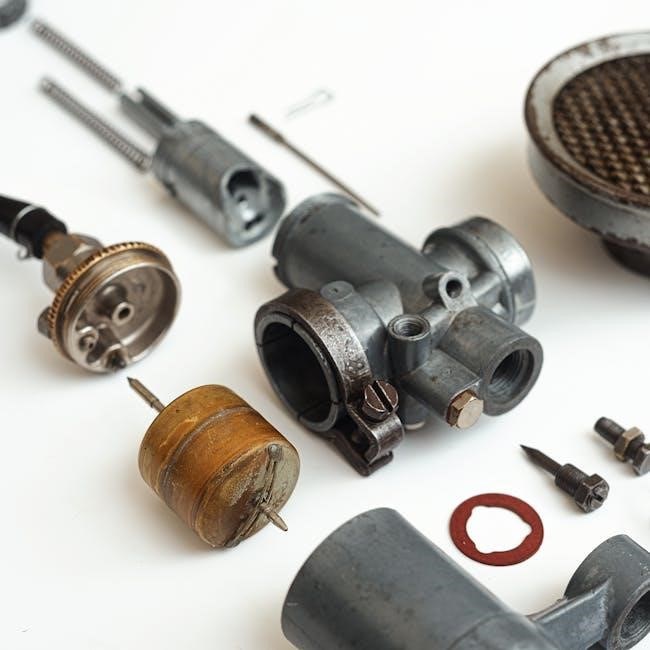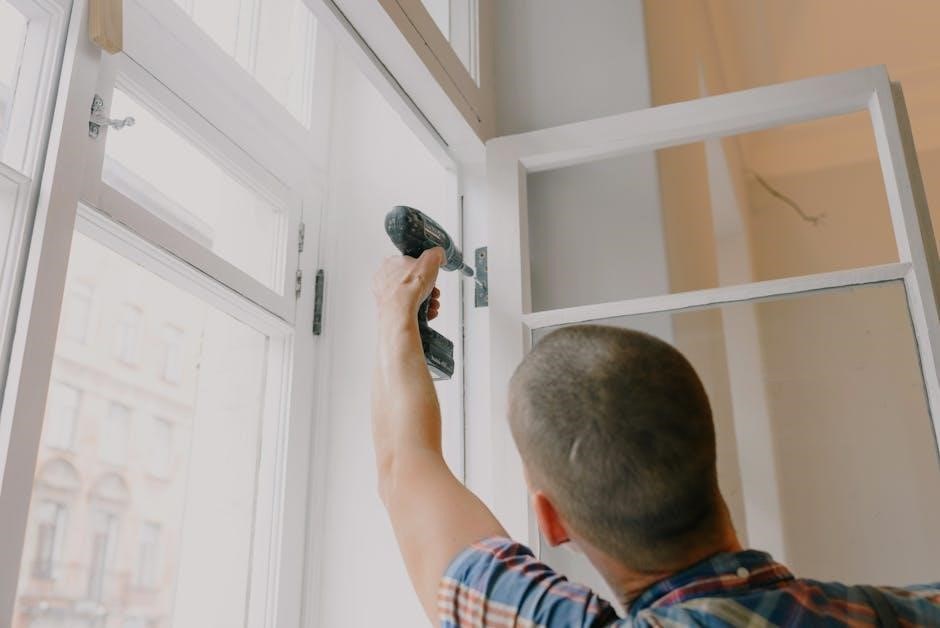The Columbus P-10 Data Logger is a versatile and reliable device designed for accurate data collection and monitoring. It offers advanced features for various industrial and environmental applications, ensuring precise measurements and efficient data management.
1.1 Overview of the Columbus P-10 Data Logger
The Columbus P-10 Data Logger is a robust, user-friendly device designed for precise data acquisition and monitoring. It is widely used in industrial, environmental, and scientific applications due to its reliability and versatility. The P-10 logger excels in capturing and storing data from various sensors, ensuring accurate measurements and efficient data management. Its compact design and ease of use make it suitable for both field and laboratory settings. With advanced features like high-resolution sensing and customizable sampling rates, the P-10 is ideal for applications requiring detailed data analysis. It supports multiple communication interfaces, enabling seamless integration with computers and other systems. The device is also known for its durable construction, making it suitable for harsh environments. Overall, the Columbus P-10 is a reliable tool for professionals needing accurate and efficient data logging solutions.
1.2 Key Features of the Columbus P-10

The Columbus P-10 Data Logger is equipped with a range of advanced features that make it a powerful tool for data acquisition. It supports multiple input channels, allowing users to monitor various parameters simultaneously. The device offers high-resolution measurements, ensuring precise data capture. Its adjustable sampling rates enable customization based on specific application needs. The P-10 also features robust data storage capabilities, with expandable memory options to handle large datasets. It supports multiple communication protocols, including USB, Ethernet, and wireless options, facilitating easy data transfer and remote monitoring. The logger is designed with a user-friendly interface, making configuration and operation straightforward. Additionally, it includes advanced alarm and notification systems, ensuring timely alerts for critical data thresholds. These features combine to make the Columbus P-10 a versatile and reliable solution for diverse data logging requirements.

Installation and Setup

The Columbus P-10 Data Logger is designed for straightforward installation and setup. Follow step-by-step hardware and software guides to ensure proper configuration and optimal performance.
2.1 Hardware Installation Steps
Begin by carefully unboxing and inspecting the Columbus P-10 Data Logger for any damage. Connect the power supply and sensors according to the manual’s wiring diagram.
Mount the device in a secure, accessible location to ensure accurate data collection. Connect all external sensors to their designated ports.
Power on the device and perform a self-test to verify proper functionality. Ensure all LED indicators are operational and displaying the correct status.
If using external antennas or communication modules, install them as directed to maintain optimal signal strength.
Finally, double-check all connections and configurations before proceeding to software setup. Consult the manual for specific installation requirements.

2.2 Software Setup and Configuration
Install the Columbus P-10 software on your computer using the provided installation media or download it from the official website. Launch the software and follow the on-screen instructions to complete the setup process.
Connect the P-10 data logger to your computer via USB or another supported interface. The software should automatically detect the device and prompt for configuration.
Configure the device settings, such as sampling rates, data formats, and storage locations. Set up user accounts and access permissions if required.
Define the logging parameters, including the types of data to be recorded and the intervals for measurements. Ensure all settings align with your specific application needs.
Save the configuration and perform a test run to verify that data is being logged correctly. Refer to the manual for troubleshooting any connectivity or software issues.
2.3 Connecting the P-10 to a Computer
To connect the Columbus P-10 Data Logger to a computer, start by locating the USB port on the device. Use the provided USB cable to establish a connection between the P-10 and your computer.
Ensure the device is powered on before connecting. Once connected, your computer should automatically detect the P-10 and install the necessary drivers.
If the drivers are not installed automatically, refer to the installation CD or download them from the official Columbus Instruments website.
After successful driver installation, open the Columbus P-10 software to verify the connection. The software should display a confirmation message indicating the device is connected.
For alternative connection methods, such as Ethernet or wireless, follow the specific instructions provided in the manual for configuring network settings.
If issues arise, restart both the computer and the P-10, then attempt the connection again. Ensure all cables are securely connected and undamaged.
Configuration of the Columbus P-10
The Columbus P-10 Data Logger offers straightforward configuration options, allowing users to customize settings such as data collection intervals, alarm thresholds, and output formats. Its user-friendly interface ensures easy navigation for both basic and advanced configurations, making it adaptable to various monitoring needs.
3.1 Basic Configuration Settings
The Columbus P-10 Data Logger requires initial configuration to ensure proper operation. Basic settings include selecting the measurement units, setting the logging interval, and defining the data storage format. Users can also configure the device’s time and date settings, ensuring synchronization with external systems. The P-10 allows for the selection of input channels and sensor types, enabling customization based on specific monitoring requirements. Additionally, users can set up basic alarm conditions to trigger notifications for out-of-range values. These configurations are typically performed via the device’s web interface or dedicated software, providing a user-friendly experience. Proper setup of these basic parameters is essential for accurate and reliable data collection. By following the manual’s guidelines, users can easily tailor the P-10 to meet their specific needs, ensuring optimal performance in various applications.
3.2 Configuring Data Logging Channels
Configuring data logging channels on the Columbus P-10 involves selecting and setting up the specific channels to monitor. Users can assign sensors to each channel, define measurement ranges, and set logging intervals. The device allows naming of channels for easy identification. Through the software interface, users can enable or disable channels based on their needs. Proper configuration ensures accurate and organized data collection, making it easier to analyze and interpret the logged information. This step is crucial for tailoring the P-10 to specific applications, ensuring that only relevant data is captured. Additionally, users can specify data formats and set up channel prioritization. Options for real-time monitoring and data storage settings can also be configured. By carefully configuring each channel, users can optimize the device’s performance and streamline their data management process, ensuring efficient and reliable monitoring.
3.3 Setting Up Alarms and Notifications
Setting up alarms and notifications on the Columbus P-10 Data Logger allows users to receive alerts when specific conditions are met. Alarms can be configured based on threshold values for temperature, voltage, or other measured parameters. Users can define upper and lower limits, and the device will trigger an alarm when these limits are exceeded. Notifications can be sent via email, SMS, or through the software interface. Customizable alert messages ensure that users are informed promptly about critical events. The P-10 also supports multiple alarm levels, enabling prioritization of notifications. Additionally, users can set up repeating or one-time alerts, depending on the application. This feature enhances monitoring efficiency by providing real-time alerts, reducing downtime, and ensuring timely responses to system changes. Properly configured alarms and notifications are essential for maintaining operational integrity and safety in various environments.

Data Logging and Management
The Columbus P-10 Data Logger efficiently captures and stores data, supporting various formats like temperature, voltage, and more. It offers flexible storage options, including internal memory and external devices, ensuring data integrity and accessibility for analysis and reporting.

4.1 Starting and Stopping Data Logging
To begin data logging on the Columbus P-10, power on the device and navigate to the main menu. Select the “Data Logging” option and choose the desired logging profile. Configure the sampling rate, duration, and channels as needed. Once settings are confirmed, press the “Start” button to initiate logging. The device will indicate active logging via an LED or on-screen notification. To stop logging, access the menu again, select “Stop Logging,” and confirm. Ensure all data is saved before shutting down the device to avoid data loss. The P-10 also supports manual or scheduled logging sessions, offering flexibility for various monitoring applications. Always review logged data to ensure accuracy and completeness before proceeding with analysis or export.
4.2 Viewing and Analyzing Logged Data
The Columbus P-10 Data Logger allows users to easily view and analyze logged data through its intuitive interface. Once data logging is complete, navigate to the “View Data” menu to access stored records. The device features a high-resolution color touchscreen, enabling clear visualization of data trends and patterns. Users can zoom in/out, pan across datasets, and apply filters to focus on specific time intervals or channels. The P-10 also supports data export to external devices or software for advanced analysis. Additionally, the Columbus Data Manager software provides tools for detailed data interpretation, including graphing, reporting, and annotation capabilities. This makes it easier to identify key insights and make informed decisions based on the collected data. The P-10 ensures that users can efficiently review and analyze their data, whether on the device or through connected systems.
4.3 Exporting Data for Further Analysis
The Columbus P-10 Data Logger simplifies data export for further analysis, offering multiple formats such as CSV, Excel, and PDF. Users can transfer data via USB, Ethernet, or wireless connections to external devices or cloud storage. The P-10’s software suite allows for seamless export, ensuring data integrity and compatibility with third-party tools. This feature is essential for detailed analysis, enabling users to leverage advanced analytics and reporting capabilities. By exporting data, users can create comprehensive reports, share insights, and integrate findings into larger projects. The P-10’s export functionality is designed to be user-friendly, making it easy to manage and utilize collected data effectively. This ensures that data can be analyzed in-depth, supporting informed decision-making and efficient workflow management.

Communication Methods
The Columbus P-10 Data Logger supports multiple communication methods, including USB, Ethernet, and wireless options, ensuring flexible and reliable data transfer to computers or networks for real-time monitoring and analysis.
5.1 USB Communication Setup
To establish USB communication with the Columbus P-10 Data Logger, connect the device to a computer using a compatible USB cable. Ensure the USB port on both the logger and the computer is functioning properly. Install the necessary drivers from the provided CD or download them from the official website. Once installed, launch the Columbus P-10 software and follow the on-screen instructions to configure the USB connection. Select the appropriate USB port from the dropdown menu within the software settings. If prompted, restart the device to complete the setup. Verify the connection by checking for a successful link indication in the software. For troubleshooting, ensure the USB cable is securely connected and drivers are up-to-date. This method provides a reliable and efficient way to transfer data directly to your computer for real-time monitoring and analysis.
5.2 Ethernet Communication Configuration
To configure Ethernet communication for the Columbus P-10 Data Logger, begin by connecting the device to a local network using a standard Ethernet cable. Ensure the network is operational and assign an IP address to the logger, either manually via static IP configuration or automatically through DHCP. Access the P-10’s web interface by entering its IP address in a web browser. Navigate to the network settings section to configure parameters such as subnet mask, gateway, and DNS servers if required. Save the changes and restart the device to apply them. Verify connectivity by pinging the device or checking the link status in the software. For troubleshooting, ensure the Ethernet cable is securely connected and the network settings are correct. This setup enables remote monitoring and data transfer over a local area network, enhancing flexibility in industrial or environmental monitoring applications.
5.3 Wireless Communication Options
The Columbus P-10 Data Logger supports wireless communication, offering flexibility for remote data monitoring. It is equipped with Wi-Fi and Bluetooth capabilities, enabling seamless connectivity to mobile devices or networks. To configure wireless settings, access the device’s control panel and select the desired wireless network. Enter the network password to establish a connection. For Bluetooth pairing, ensure the logger and target device are in discovery mode and confirm the connection. Wireless communication allows for real-time data transmission, reducing the need for physical cables. This feature is particularly useful in harsh or hard-to-reach environments. Ensure strong signal strength for reliable data transfer. Regularly update wireless drivers and firmware to maintain optimal performance. Wireless connectivity enhances the P-10’s versatility, making it ideal for applications requiring remote monitoring and data accessibility.
Power Management
The Columbus P-10 Data Logger efficiently manages power through advanced battery and external supply options, ensuring continuous operation in diverse environments with minimal downtime and optimal energy utilization.
6.1 Battery Installation and Maintenance
Installing and maintaining the battery in your Columbus P-10 Data Logger is crucial for ensuring reliable operation. Always use the battery type recommended by the manufacturer to avoid damage. Before installation, ensure the battery terminals are clean and free from corrosion. Insert the battery following the polarity markings on the device. Regularly check the battery level and recharge or replace it as needed. Store unused batteries in a cool, dry place to preserve their lifespan. Avoid extreme temperatures, as they can degrade battery performance. Clean the terminals periodically with a soft cloth to maintain proper conductivity. If the battery is not in use for an extended period, discharge it to about 50% capacity before storage. Proper maintenance ensures optimal performance and extends the life of your Columbus P-10 Data Logger.
6.2 External Power Supply Options
The Columbus P-10 Data Logger can be powered using an external power supply, ensuring continuous operation in scenarios where battery power is not feasible. The device supports a wide range of external power sources, including AC adapters and DC power inputs. When using an external power supply, ensure it meets the voltage and current requirements specified in the manual to prevent damage. Connect the power supply to the designated port on the P-10, following the polarity guidelines provided. For extended use, consider using a high-quality, regulated power supply to maintain stable performance. Always verify the compatibility of the external power source with the P-10’s specifications to avoid any potential issues. Proper use of an external power supply enhances the reliability and longevity of the device, making it ideal for long-term deployments or industrial applications.

Maintenance and Troubleshooting
Regular maintenance ensures optimal performance of the Columbus P-10 Data Logger. Clean the device, check connections, and update software periodically. Troubleshooting common issues like sensor malfunctions or connectivity problems can be resolved by following the manual’s guidelines or resetting the device if necessary. Always refer to the troubleshooting section for detailed solutions to specific errors, ensuring minimal downtime and maintaining data accuracy. Proper care extends the lifespan and reliability of the P-10, making it a durable solution for data logging needs. By addressing issues promptly, users can ensure uninterrupted data collection and maintain the integrity of their recordings. Regular checks and timely interventions are key to sustaining peak performance. This approach helps in identifying and resolving potential problems before they escalate, ensuring smooth operation. Additionally, keeping the device firmware updated is crucial for accessing new features and improvements. Users should also maintain a backup of logged data to prevent loss in case of system failures. Overall, consistent maintenance and proactive troubleshooting are essential for maximizing the efficiency and longevity of the Columbus P-10 Data Logger.
7.1 Regular Maintenance Tips
Regular maintenance is crucial for ensuring the Columbus P-10 Data Logger operates efficiently. Clean the device periodically with compressed air or a soft cloth to remove dust and debris. Check the battery level and replace it when necessary to avoid data loss. Inspect sensors and connections for damage or corrosion, and tighten any loose wires. Update the firmware regularly to access new features and improvements. Backup logged data frequently to prevent loss in case of system failure. Store the device in a dry, cool place when not in use to protect it from environmental damage. Perform these tasks consistently to extend the lifespan and reliability of the P-10, ensuring accurate and uninterrupted data collection.
7.2 Common Issues and Solutions
Common issues with the Columbus P-10 Data Logger include power failures, communication errors, and data loss. For power issues, ensure the battery is fully charged or connected to an external power source. If the device fails to communicate via USB or Ethernet, check the cable connections and reinstall drivers. Data loss can occur due to improper shutdown; always save and backup data regularly. Sensor inaccuracies may arise from calibration errors; recalibrate sensors as needed. Firmware updates can resolve software glitches. If the device freezes, restart it or perform a factory reset. For persistent issues, consult the manual or contact technical support. Regular maintenance and updates help minimize these problems, ensuring smooth operation and reliable data collection.
7.3 Resetting the Columbus P-10
Resetting the Columbus P-10 Data Logger can resolve software-related issues or restore factory settings. To perform a reset, navigate to the device’s settings menu and select the “Reset” option. Confirm the action to initiate the process. The device will reboot, restoring default configurations. Note that resetting will erase all custom settings and logged data, so ensure data is backed up before proceeding. For a factory reset, press and hold the reset button located at the rear of the device for 10 seconds while powered on. Release the button and wait for the device to complete the reset process. After resetting, reconfigure the device according to your requirements. Refer to the manual for detailed instructions and precautions to avoid data loss. Regular resets can help maintain optimal performance and troubleshoot persistent issues effectively.

Conclusion
The Columbus P-10 Data Logger is a powerful tool designed to meet the demands of precise data collection and monitoring. With its advanced features, user-friendly interface, and robust performance, it is an essential solution for various applications. By following the guidelines outlined in this manual, users can optimize the device’s functionality, ensuring accurate and reliable data logging. Regular maintenance and updates are crucial to maintaining its performance. Whether for industrial, environmental, or research purposes, the Columbus P-10 delivers exceptional results. Its versatility and durability make it a valuable asset for professionals seeking efficient data management. Refer to this manual for detailed instructions to unlock the full potential of the Columbus P-10 and ensure seamless operation in your specific use case.






































































